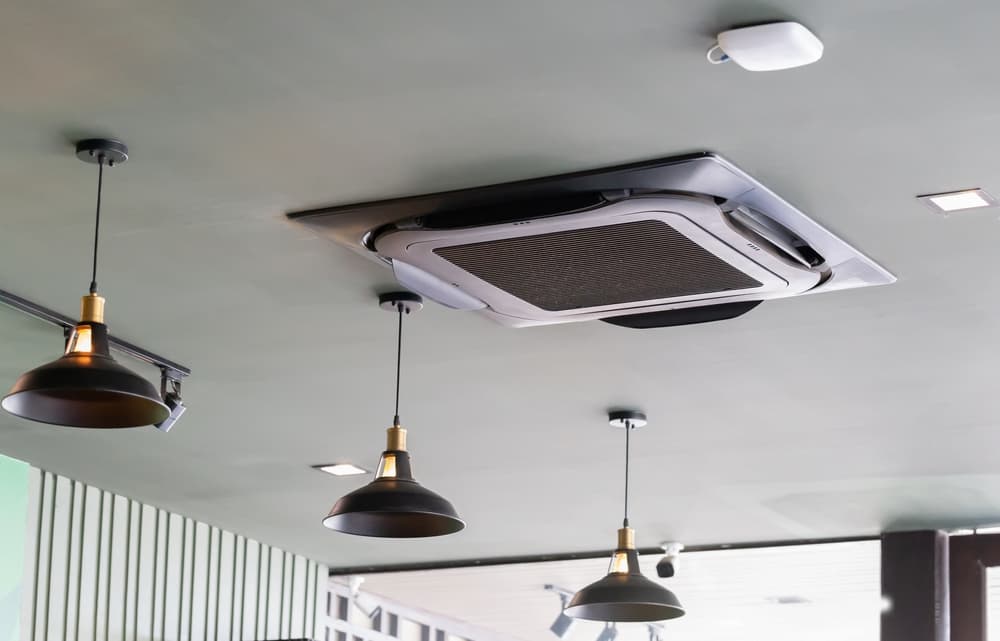Aesthetic Design and Space Saving:
Saving space and blending in with the interior of the room are two major benefits of ceiling-mounted mini-split air conditioners. Ceiling cassettes are positioned flat with the ceiling, freeing up the walls and floors for other uses, in contrast to wall-mounted or floor-standing units that take up valuable space and could detract from the room’s aesthetic. In smaller rooms or areas where optimizing usable space is crucial, this feature is especially helpful. For example, in small offices or apartments, the lack of a large air conditioner on the wall improves the room’s general usability and aesthetic appeal. Additionally, they are perfect for settings like restaurants, retail establishments, and contemporary residences where keeping a tidy and professional look is essential due to their sleek and understated style.
Even Air Distribution to Improve Comfort:
The capacity of ceiling-mounted mini-split systems to distribute air evenly across the space is one of its best qualities. Every area of the space is continuously conditioned thanks to these units’ multidirectional air outlets, which enable warm or cool air to circulate in various directions. Even in bigger buildings or open-plan layouts, ceiling cassettes offer balanced heating or cooling, in contrast to older systems that could produce inconsistent temperatures or “hot spots.” This is especially helpful in places where regular comfort for residents or clients is crucial, such as conference rooms, spacious living areas, or retail establishments.
Outstanding Energy Efficiency:
When selecting an air conditioning system, energy economy is a crucial consideration, and ceiling-mounted mini-split units are excellent at it. With the help of cutting-edge inverter technology, these systems minimize energy usage by adjusting their heating or cooling output according to the demands of the space. Inverter-driven mini-splits run constantly at different speeds, drastically lowering electricity consumption in contrast to traditional HVAC systems that regularly cycle on and off. Additionally, a lot of ceiling-mounted units have motion sensors that can identify when a room is occupied, enabling the system to adjust how much it operates. These systems are a wise investment for environmentally aware people and companies since they not only save energy costs but also support environmental sustainability.
Silent Operation for a Calm Setting:
The exceptionally silent functioning of ceiling-mounted mini-split air conditioners is another important benefit. The design of mini-split systems isolates the outdoor compressor unit from the indoor air-handling unit, in contrast to standard HVAC systems where noisy compressors and air handlers can ruin the atmosphere. Because of this isolation, the indoor unit runs at whisper-quiet levels, which makes it perfect for spaces where noise may be an issue, such as offices, libraries, and bedrooms. Because of the quiet operation, residents can work, unwind, or sleep more soundly without being disturbed by the hum of a conventional air conditioner.
The Ability To Heat And Cool Simultaneously:
Because they can be used for both heating and cooling, ceiling-mounted mini-split systems are a year-round option for preserving indoor comfort. They provide effective cooling in the sweltering summer months and dependable warmth in the winter months thanks to their reverse-cycle technology. Installing and maintaining separate heating systems is no longer necessary thanks to this dual functionality. Furthermore, regardless of the season, these energy-efficient units provide substantial electricity bill savings. Having a single system that can handle all temperature control requirements is convenient and economical for both businesses and homeowners.
Adaptable and Intelligent Features:
A variety of programmable options that accommodate different tastes and lifestyles are included in contemporary ceiling-mounted mini-split systems. Numerous units come with programmable timers that let customers plan when to operate them based on their schedules, guaranteeing maximum comfort and reducing energy waste. The majority of systems also come with smartphone connectivity or remote controls, which let users conveniently change settings from anywhere in the room or even remotely when connected to smart home platforms. To improve user convenience and control, some more sophisticated versions also come with voice command capabilities and compatibility with virtual assistants like Google Assistant and Amazon Alexa.
Better Air Quality Indoors:
Concern over indoor air quality is growing, particularly in cities where allergies and pollution are common. To solve this problem, ceiling-mounted mini-split systems use cutting-edge filtration technologies that collect dust, pollen, mould spores, and other airborne pollutants. In addition to enhancing the quality of the air, these filters make the living space healthier for everyone, especially those who suffer from allergies or respiratory conditions. Additionally, some units have dehumidification features, which eliminate surplus moisture from the air to stop the growth of mildew and keep the interior comfortable. These systems improve comfort and health by fusing improved air filtration with effective cooling.
Sturdiness and Minimal Upkeep Needs:
Mini-split systems are renowned for their longevity and robustness. These units are a wise investment because they can run effectively for 15 to 20 years with the right upkeep. Mini-splits also require less maintenance than standard ducted systems because they don’t have as much ductwork, which can collect dust and debris. To guarantee optimum performance, routine maintenance usually entails cleaning or replacing the filters as well as occasional professional servicing.
Frequently Asked Questions:
1. Why Is SEER Significant, And What Is It?
The efficiency of an air conditioning system is shown by the Seasonal Energy Efficiency Ratio, or SEER. Better energy efficiency and cheaper utility costs are associated with a higher SEER rating. When buying a new AC system, selecting a unit with a higher SEER is crucial because it can save money over time.
2. What Time Of Year Is Ideal For Installing An Air Conditioner?
Since HVAC professionals are less busy during off-peak seasons, usually spring or fall, this is the ideal time to install an air conditioner. Better availability and pricing may result from this. Making preparations in advance guarantees that your system is prepared for the upcoming hot summer months.


